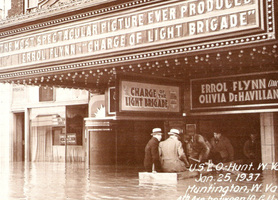 | Back to e-WV
| Back to e-WV
 The West Virginia Encyclopedia
The West Virginia Encyclopedia
 | Back to e-WV
| Back to e-WV
 The West Virginia Encyclopedia
The West Virginia Encyclopedia

In January 1937, the Ohio Valley was visited by its worst disaster ever-–a flood that drove a million people from their homes, claimed nearly 400 lives, and caused $500 million in damages. No West Virginia community along the Ohio escaped the flood’s ravages.
There had been Ohio River floods before. When the first settlers made their way into the valley, they found the river was subject to dramatic changes. When the weather was dry, it could be so shallow that one early settler described it as “a mile across and a foot deep.” Yet the Ohio could become a torrent after a heavy rain or sudden thaw.
January 1937 was unusually warm. Melting snow and 19 straight days of rain combined to create the right conditions for flooding along the Ohio’s entire 981-mile length from Pittsburgh to Cairo, Illinois, where it joins the Mississippi.
Wheeling had experienced its worst flood in March 1936 when the Ohio River crested at a record 55.2 feet, more than 15 feet above flood stage. During the 1937 flood, the river rose two inches an hour, cresting at nearly 47 feet. The water soon covered much of the city. As happened in 1936, Wheeling Island was submerged and authorities ordered its 10,000 inhabitants evacuated.
At Parkersburg on January 26, the 1937 flood crested at 55.4 feet, 19.4 feet above flood stage, but citizens mostly took it in stride. At City Hall, the police and fire departments continued operating, even though the only way to get to and from the building was by boat.
On January 28, the Ohio River at Huntington reached 69.45 feet, more than 19 feet above flood stage. It inundated most of the city’s downtown and forced thousands of residents from their homes. Relief centers in churches and schools fed as many as 9,000 people a day. By the time the water receded, five people were dead, and the city was in ruins.
The 1937 flood prompted the federal government to erect floodwalls to protect Ohio River communities and flood-control dams and reservoirs that in the years since have prevented untold devastation along the Ohio River.
Written by James E. Casto